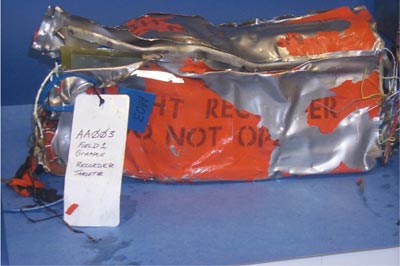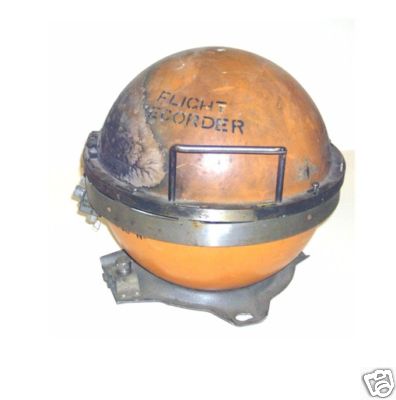Flight Recorders are the new black

I’ve been geeking out really, really hard on flight recorders lately. My next project is related, and I’ve been tracking down as much information as possible on these amazing things. You know what I’m talking about- black boxes. They often offer key audio and to any doomed flight. I’m totally obsessed with them at the moment, and while a tad macabre, they are amazing hunks of technology filled to their gills with near on indestructible electrostuffs.
more after the cut.
Flight Data Recorders (FDR’s) are on every airplane, constantly recording a myriad of information from sensors around the plane. They record in a loop- let’s say 30 minutes- so in the event of a crash, only the last 30 minutes before the final scene are recorded. You know, the good bits- forensically speaking, of course. JG Ballard seems fond of them.
In doing research, I came across this article from How Stuff Works (one of my favorite sites, and also one of my favorite podcasts). It’s pretty in depth, but the part I want (have) to quote you is the ridiculous/incredible destructive testing they do on these things. I would be tickled FDR orange to see any of these in progress:
(via Howstuffworks)
- Crash impact – Researchers shoot the CSMU down an air cannon to create an impact of 3,400 Gs (1 G is the force of Earth’s gravity, which determines how much something weighs). At 3,400 Gs, the CSMU hits an aluminum, honeycomb target at a force equal to 3,400 times its weight. This impact force is equal to or in excess of what a recorder might experience in an actual crash.(note: in my research, I found certain companies that tested their units to a mind-shattering 30,000 g’s!)
- Pin drop – To test the unit’s penetration resistance, researchers drop a 500-pound (227-kg) weight with a 0.25-inch steel pin protruding from the bottom onto the CSMU from a height of 10 feet (3 m). This pin, with 500-pounds behind it, impacts the CSMU cylinder’s most vulnerable axis.
- Static crush – For five minutes, researchers apply 5,000 pounds per square-inch (psi) of crush force to each of the unit’s six major axis points.
- Fire test – Researchers place the unit into a propane-source fireball, cooking it using three burners. The unit sits inside the fire at 2,000 degrees Fahrenheit (1,100 C) for one hour. The FAA requires that all solid-state recorders be able to survive at least one hour at this temperature.
See? The FDR is the Chuck Norris of the aviation world. I want to be in that room when they come up with these tests- ‘I know, lets wrap it in bacon, and put it in a room of warewolves’.
Despite the huge initial prices of FDR’s, they have to be replaced every few years. Hence, you can get them on ebay- for relatively cheap, even. It’s the shipping that will kill you. I know this because in a near fanatical burst of geeky glee I lusted after and purchased this hunk of spherical russian steel-sex:

Yes, I know, it’s awesome. Before I stuff it with electronics, I plan to use it as a serving dish.